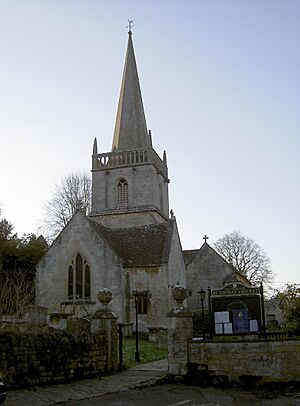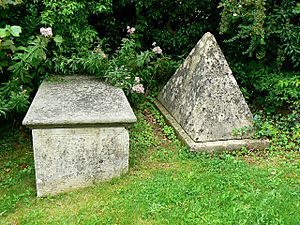Church of St Thomas à Becket, Box facts for kids
Quick facts for kids Church of St Thomas à Becket |
|
|---|---|
 |
|
| 51°24′54″N 2°15′21″W / 51.4151°N 2.2558°W | |
| Denomination | Church of England |
| Previous denomination | Roman Catholic |
| History | |
| Dedication | St Thomas Becket |
| Architecture | |
| Functional status | Parish church |
| Heritage designation | Grade I |
| Architectural type | Church |
| Administration | |
| Parish | Box |
| Deanery | Chippenham |
| Archdeaconry | Malmesbury |
| Diocese | Bristol |
The Church of St. Thomas à Becket is an old and important church in Box, Wiltshire, a village in south-west England. It belongs to the Church of England. This church is one of many named after Thomas Becket, a famous archbishop who was killed a long time ago.
The church building started in the 1100s. Over the years, it was changed and updated many times. These changes happened in the 1300s, 1400s, 1700s, and 1800s. Today, it is a Grade I listed building, which means it's a very special historic place.
Contents
History of the Church
Early Beginnings
The church stands next to the ruins of an old Roman villa. This shows that people have lived in this area for a very long time. There is also evidence that St Aldhelm, an important religious figure, worked here. An Anglo-Saxon church was built first, and then a Norman church replaced it. This early church was known as Ditchridge.
After the Normans took over England, King William I gave the land and church to William De Ow. The church was rebuilt between 1158 and 1169. Stone for the new building came from the nearby Hazelbury quarry.
Dedication to St Thomas Becket
At first, the church was dedicated to the Virgin Mary. However, after Thomas Becket, the Archbishop of Canterbury, was killed in 1170, a small chapel was built for him in 1190. Box was on the path that pilgrims took to visit Becket's shrine at Canterbury Cathedral. Because of this, by the end of the 1200s, the whole church was rededicated to St Thomas Becket. The small chapel was then renamed the Hazelbury Chapel.
Changes Over the Centuries
Many parts of the church were built or changed in the 1300s. These include the arches in the tower and the north arcade. A two-story room, possibly a priest's house, was also added. The roof of the chapel was built with a special ribbed arch design.
In the 1400s, the church tower was made taller, and a bell was put in. Later, in 1713, the chancel (the part of the church where the altar is) was rebuilt.
Victorian Enlargement and Restoration
By 1831, the church was too small for everyone who wanted to attend. So, during the Victorian era, it was made bigger. John Pinch the Younger, an architect from Bath, designed the new south aisle.
More work was done in 1896–1897 by Harold Brakspear. A porch was added to the vestry. Inside, the tall pews were removed and made lower, and the floor was also lowered. Plaster was taken off the walls, revealing old memorials and beautiful 14th-century encaustic tiles in the chancel. These tiles were also repaired. Brakspear also designed the reredos (a decorated screen behind the altar) and installed a stone pulpit. This restoration cost about £3,500 at the time. The Hazelbury Chapel was restored again in 1926.
In 1960, English Heritage officially recognized the Church of St Thomas à Becket as a Grade I listed building. This means it is a very important historical site.
Unique Features
The north-east Hazelbury Chapel is considered "highly unusual" by experts. The reredos on the east wall of the nave is thought to be from the 1200s. It is similar to one found in Salisbury Cathedral.
The church has an octagonal (eight-sided) font from the 1400s, which is used for baptisms. The tower holds four bells. One bell is from the 1400s, and another is from the 1500s. The church has an Ellacombe apparatus, which allows one person to ring all the bells without a full team of bell-ringers. You can also see the royal arms of Queen Anne, dated 1714.
Among the monuments, there is a large, decorated urn and obelisk for Margaret Blow, who passed away in 1755. This monument is thought to be by the famous sculptor Henry Cheere.
Churchyard and Cemetery
Old Grave Markers
The churchyard has grave markers that date back to the 1600s. You can see many mounds where bodies were buried one on top of another. In medieval times, these "double burials" were usually on the south side of the church. This was because people believed no one wanted the church's shadow to fall on their grave.
There is a local story about a unique pyramidal (pyramid-shaped) tombstone in the churchyard. Legend says it was built this way to stop the person's wife from dancing on his grave!
Box Cemetery
Burials in the churchyard became less common after the Box cemetery opened in 1858. The cemetery has a chapel built in 1857. It is a rectangular building with a tall, pointed spire. Experts describe it as "unusually elaborate Gothic" because of its detailed design. It uses different colored stones and has highly carved window patterns. The lodge, a small building at the cemetery entrance, was built at the same time and has a similar style.
Parish and Vicarage
The Lidbrook Group
At some point, the church's parish was joined with those of Hazlebury and Ditteridge, even though they are still separate areas. Today, the parish is part of the Lidbrook Group. This group also includes St John's church in Colerne.
Vicarage History
Rev. I. W. W. Horlock, who was the vicar, built Box House around 1810–1820 for himself. It was a large, three-story house with two Ionic columns in front of an arched doorway, surrounded by gardens. His son, Rev. H Horlock, continued to live there as the vicar until he retired in 1874. Today, Box House and its additions are used as offices. A different three-story house on Church Lane, built in the mid-1800s, was then bought and is still used as the vicarage today.
Notable Burials
- Sir Hugh Speke, 1st Baronet (1661)
- Sir George Speke, 2nd Baronet (1683)


